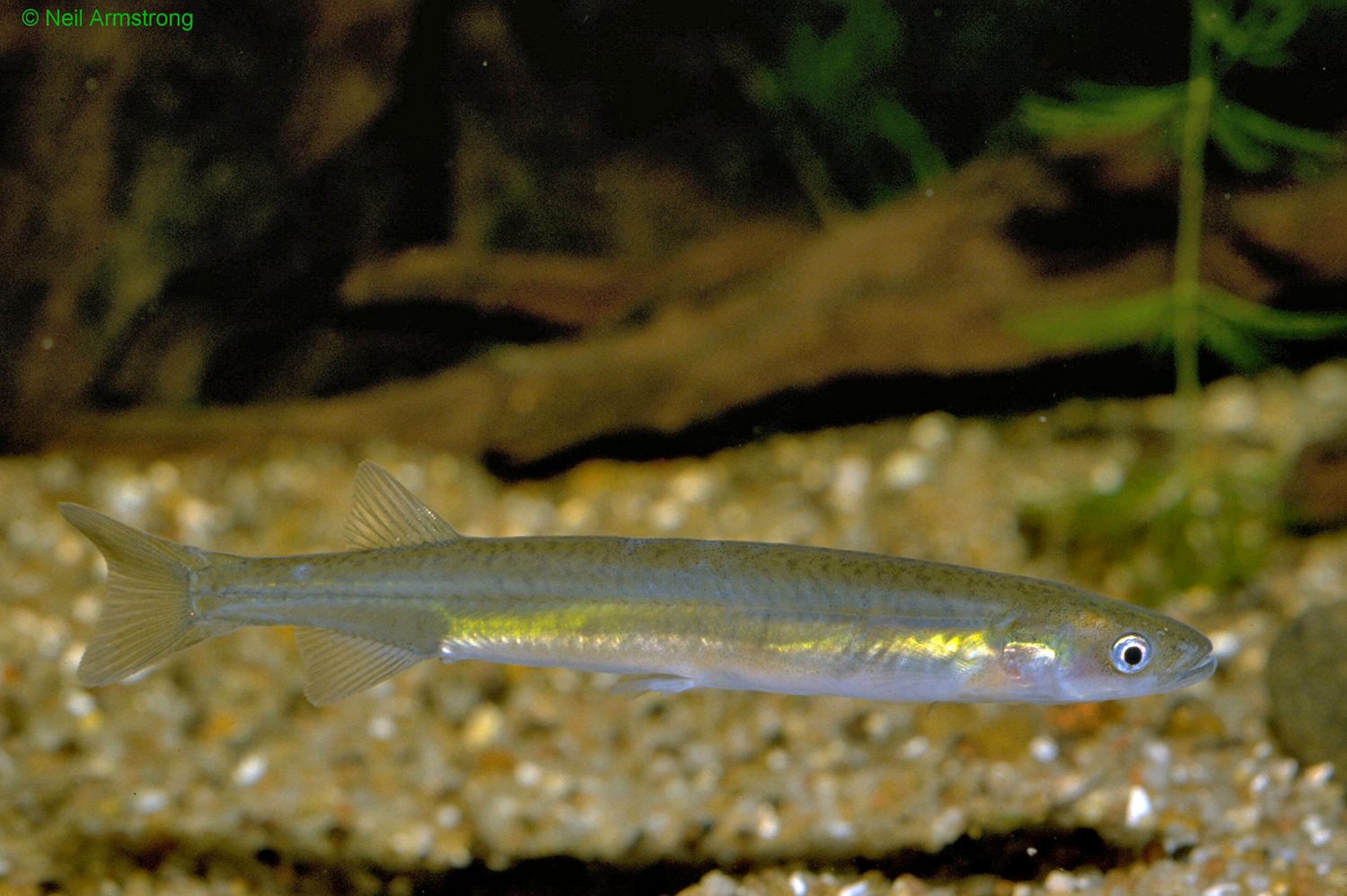Flathead Galaxias, Galaxias rostratus Klunzinger 1872

Flathead Galaxias, Galaxias rostratus. Source: Neil Armstrong. License: All rights reserved
A long, slender galaxias with a distinctly flattened head, and very small pectoral and pelvic fins that are not fleshy at their bases.
Greenish-olive on back and sides, with irregular dark greyish-green blotches, bright silvery below lateral line, fins clear, eye silver.
The Flathead Galaxias is considered to be extinct in South Australia.
Flathead Galaxias, Galaxias rostratus Klunzinger 1872
More Info
|
Distribution |
Endemic to the Murray Darling river system, and known historically from Rankins Lagoon, Bathurst, NSW (33º25’S), south and south-west through intermittent localities of as far as Mannum, South Australia (139º18’E). The Flathead Galaxias inhabits still or gently flowing water on the margins of lakes, billabongs and streams. It usually occurs in shoals in midwater over rocky or sandy bottoms near aquatic vegetation. |
|
Features |
Meristic features: Body elongate, slender; head flattened; snout relatively pointed; mouth large, reaching well below eyes; jaws equal; lateral canine teeth absent from jaws; depth at vent 10.1-14.2% SL; Caudal fin slightly forked; dorsal fin well behind ventral fins, origin above vent, just forward of the anal fin; anal fin base is longer than dorsal fin base; pectoral fins small. |
|
Size |
To around 12 cm SL, commonly to 9 cm. |
|
Colour |
Back and sides olive-green with indistinct darker grey-green blotches; silvery on the ventral surface; fins mainly clear; eyes silver. |
|
Feeding |
Likely to be carnivorous feeding on small crustaceans and aquatic insects. |
|
Biology |
Spawning occurs in small ponds when water temperatures are between 9 and 14°C. Demersal eggs are deposited in mid-water by the female and then settle to the bottom. Eggs are 1.3-1.6mm in diameter. Larvae hatch after around 9 days at 6-7 mm TL. |
|
Conservation |
|
|
Similar Species |
Similar in appearance to Galaxias maculatus, but differs in having a distinctively flattened head. large eyes, a distinctly flatter head, a longer snout and the mouth reaching well below the eyes (vs to the front of the eye). |
|
Species Citation |
Galaxias rostratus Klunzinger, 1872, Arch. Naturg. 38(1): 41. Type locality: Murray River, South Australia. |
|
Author |
Martin F. Gomon & Dianne J. Bray |
Flathead Galaxias, Galaxias rostratus Klunzinger 1872
References
Allen, G.R. 1989 Freshwater fishes of Australia. T.F.H. Publications, Inc., Neptune City, New Jersey.
Allen, G. R. , H. Midgley, and M. Allen 2002 Field guide to the freshwater fishes of Australia. Field guide to the freshwater fishes of Australia.: I-xiv + 1-394.
Klunzinger C.B. (1872) Zur Fische-fauna von Süd Australien. Arch. Naturg. 38(1): 17-47.
Lintermans, M. 2007. Fishes of the Murray-Darling Basin : an introductory guide. Canberra : Murray-Darling Basin Commission, 157 pp.
Llewellyn, L.C. 1971. Breeding studies on the freshwater forage fish of the Murray-Darling River system. The Fisherman N.S.W. 3(13): 1-12.
McDowall, R.M. (ed.) 1980. Freshwater fishes of south-eastern Australia. Terrey Hills, N.S.W.: Reed, 208p.
Merrick, J.R. & G.E. Schmida. 1984. Australian freshwater fishes: biology and management. Griffin Press Ltd., South Australia. 409 p.
Paxton, J.R., D.F. Hoese, G.R. Allen & J.E. Hanley. 1989. Zoological Catalogue of Australia. Volume 7. Pisces. Petromyzontidae to Carangidae. Australian Government Publishing Service, Canberra. Zoological Catalogue of Australia. Volume 7. v. 7: i-xii + 1-665.
Wager, R. 1996. Galaxias rostratus. In: IUCN 2012. IUCN Red List of Threatened Species. Version 2012.2. <www.iucnredlist.org>. Downloaded on 12 November 2011.


